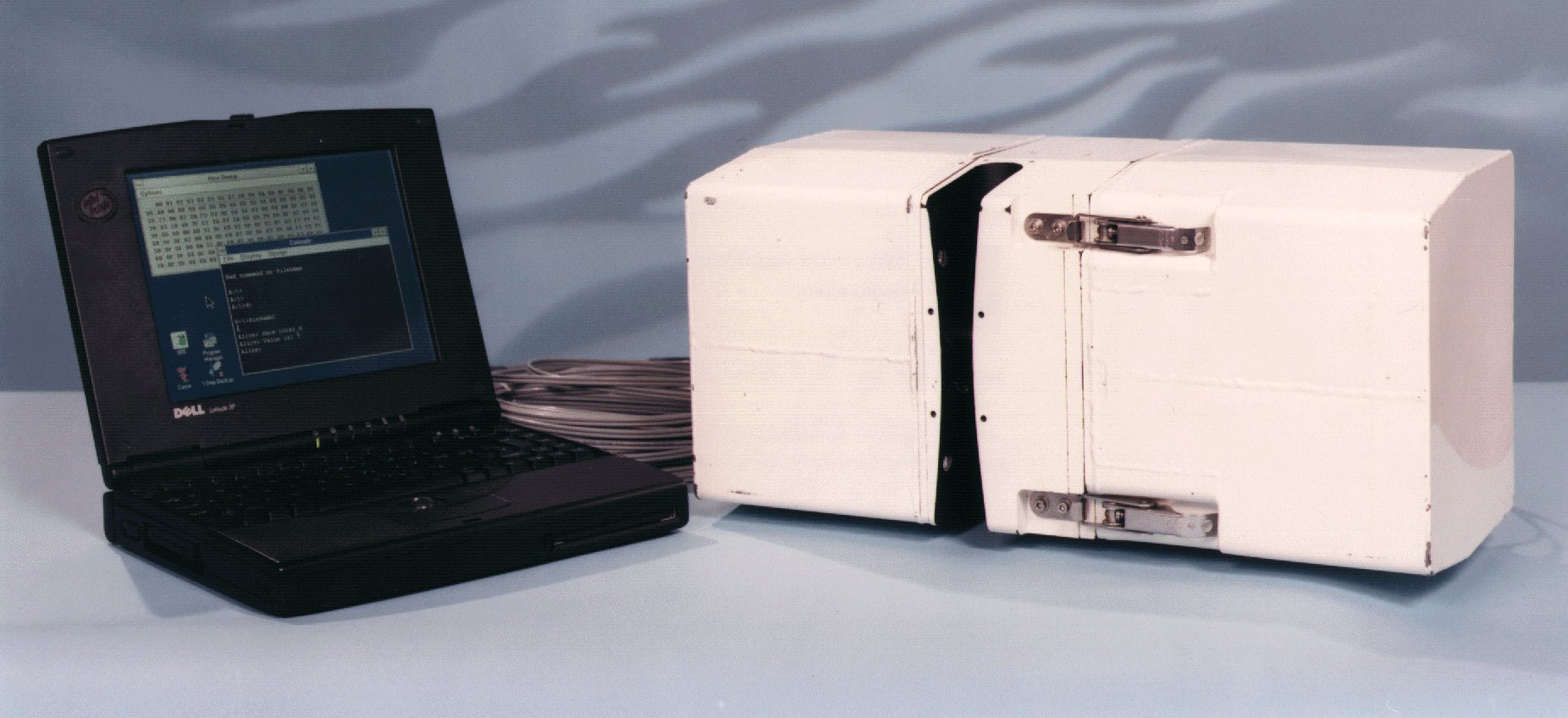
The ATSR Project
|

The SISTeR Validation Radiometer
The SISTeR (Scanning Infrared Sea Surface Temperature Radiometer) is a compact and robust chopped self-calibrating filter radiometer. It measures approximately 20 × 20 × 40cm and weighs about 20kg. The instrument is divided into three compartments containing the foreoptics, scan mirror and reference black bodies, and a small-format PC with signal processing and control electronics. The SISTeR has been designed to survive and maintain its calibration over extended periods in a maritime environment. The foreoptics and electronics compartments are waterproof and the scan mirror and black bodies are carefully protected with interleaved baffles.

|
|
Figure 1 The SISTeR radiometer and supporting equipment. |
The foreoptics compartment contains a DLATGS pyroelectric detector and preamplifier, mounted onto assembly containing a concentric 6-position filter wheel and a black rotating chopper. The filter wheel presently contains three narrow-band filters centred at 3.7µm, 10.8µm and 12.0µm, matching those in the ATSR instruments. The beam is chopped at 100Hz, a compromise between the optimum noise performance of the detector and a fast filter response in the signal processing chain. The main optical element is an ellipsoid mirror, by which the detector can view a 45° scan mirror through a anti-reflection coated ZnSe window.
The scan mirror can direct the detector's view to either of two internal black bodies or to the external scene at any point about an arc spanning 180° from nadir to zenith. Two concentric baffles surround the scan mirror. A field plane is centred in an exit aperture in the outer baffle, so that the aperture can be made as small as possible and provide the maximum internal protection. The full cone angle of the instrumental field of view is approximately 13°.
The self-calibrating design of SISTeR is intrinsically tolerant of contamination to its optics. The entire optical system is referred to two highly accurate reference black bodies. One floats near to ambient temperature and the other at approximately 10K above ambient temperature. Embedded in each black body is a 27W. RhFe thermometer. The entire black body cavity can be installed in a specially-constructed calibration block maintained by Oxford University, and the thermometer calibrated to an absolute accuracy of better than 14mK relative to ITS90. As the ambient temperature on a boat or ship is generally very near to the sea surface temperature, the cooler black body temperature always tracks that of the sea.
SISTeR Operation
All aspects of the SISTeR instrument, from the scan mirror position to the detector signal are accessible through variables defined in a C library. Control programs of arbitrary complexity can be written, but generally just a few lines of code are needed to define a scan sequence. When a control program is running, the complete instrument state is transmitted over a serial link to a laptop ground station after every measurement.
All SISTeR measurement sequences contain repeated measurements of its two internal black bodies. In addition, to calculate the skin SST, the SISTeR is programmed to make measurements both of upwelling radiances from the sea surface and complementary downwelling sky radiances.
In the SISTeR longwave channels, the measured noise temperature for a 1 second sample at typical SSTs is less than 30mK. Measurements of an external CASOTS black body [1] before, during and after a typical one-month validation campaign showed that the SISTeR calibration remained repeatable to better than 20mK, even though the scan mirror finish had deteriorated noticeably over the same period. The SISTeR has taken part in seven campaigns so far, in Mutsu Wan, the English Channel and in the Atlantic and Pacific oceans.
Skin SST Measurements
Typically, SISTeR radiances are sampled every 0.8s with the 10.8µm filter. Skin SSTs are calculated from the upwelling ocean radiance samples, corrected for a small reflected sky radiance term with the complementary sky samples. Over a flat sea surface and for a narrow filter function, the upwelling radiance can be approximated closely as
R_up = B(SST) + (1 - e) R_down
where R_up and R_down are the upwelling sea and complimentary downwelling sky radiances, e is the emissivity of the sea surface and B(T) is the Planck function, each integrated over the instrumental filter function and field of view. R_up and R_down are measured directly by the SISTeR, and so the term B(SST) and hence the skin SST can be retrieved from these.
SISTeR Mounting and Support
The SISTeR is generally mounted as far forward and as high as possible on the host ship, so that it is clear of "green water" and spray, and can view undisturbed water forward of the bow wave. Where possible, the viewing angle to the sea is kept within the range 15° - 40° from nadir [2]. The instrument also requires a clear view to the sky at the complementary angle from zenith.
The SISTeR is equipped with a quick release mount and is provided with a small turret, to which a mating bracket is attached. The turret should be mounted on a horizontal surface with a pattern of eight holes (see diagrams, dimensions in millimetres). A small horizontal platform, with the pattern pre-drilled, is also available and can be attached to handrails with U-bolts (see photo).
The SISTeR requires 24V DC power and serial data connections. Instrument data is logged remotely on a laptop PC. Waterproof power supplies, serial modems and cable sets are available for runs of 100m or more with terminations for a variety of mains outlets.
References
| [2] |
C.J. Donlon and T.J. Nightingale, 2000: Effect of atmospheric radiance errors in radiometric sea-surface skin temperature measurements. Applied Optics, 39, 2387-2392. |

|

|
